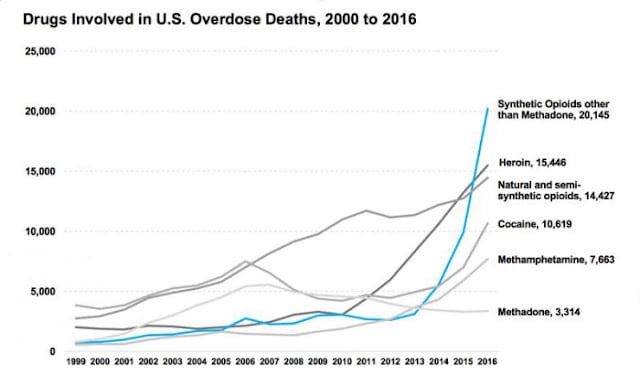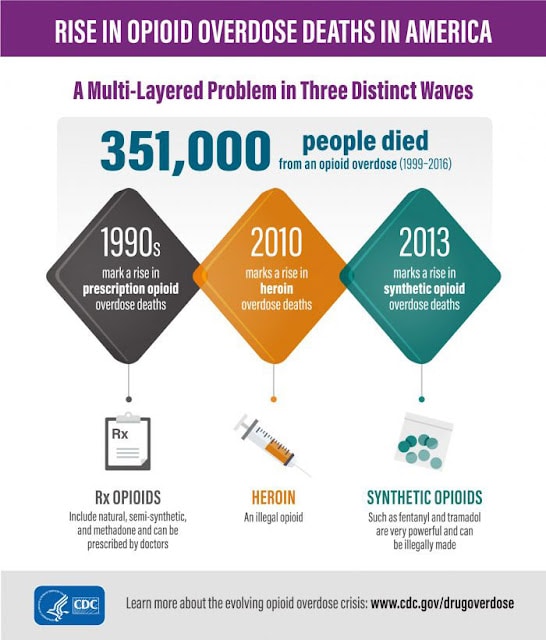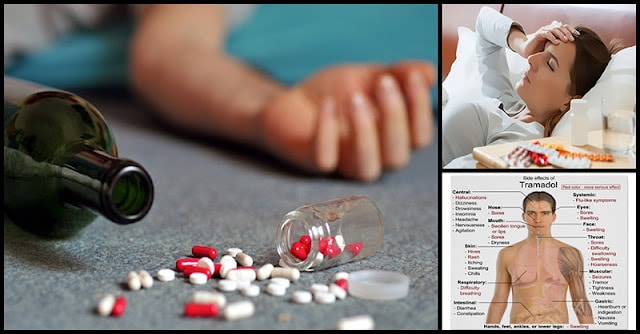When you hear the word addiction, what do you usually think? Is it things like heroin, cocaine, marijuana, or alcohol?
Addiction is defined as the compulsive need for and use of a habit-forming substance. In the U.S., there is a bigger problem related to substance abuse and painkiller addiction. Tramadol (Ultram), a pain reliever that is similar to morphine and extremely addictive, is one of the additions that is responsible for an alarming number of deaths.
It was in 2016 that the American Society of Addiction Medicine has reported that there were over 2 million Americans age 12 and older who had a substance abuse disorder involving painkiller medications.
Below is the graphic posted by the National Institute On Drug Abuse emphasizing the rising problem of deaths caused by overdose in the past seventeen years. Tramadol specifically is grouped with Fentanyl in the “Synthetic Opioids other than Methadone” category, according to the U.S. Centers for Disease Control (CDC).
 |
| Image Source: NIH |
This graphic from the CDC also dictates how the numbers of opioid/painkiller addiction and death rose in 2013 and have only continued to rise.
 |
| Image Source: CDC |
The statistics shown in the image above should serve as a wake-up call to doctors as well as patients. Yes, it’s true that pain relievers are part of treatment for some patients, however, it should never be prescribed or given without careful consideration.
What Is Tramadol And Why Is It Dangerous?
Tramadol falls under the category of opioid and narcotics. It is a powerful synthetic pain reliever and is being used to treat moderate to severe pains.
It works by binding to receptors in the brain that are responsible for alerting the body of pain.
Its side effects include fainting, memory loss, nausea, blood in urine, bloating, increased blood pressure, chills, and increased heart rate.
Professor Jack Crane, a former Northern Ireland State Pathologist and leading expert in forensic medicine, says that:
“People seem to assume that Tramadol is safe because it is prescribed by doctors, but in my mind it is just as dangerous as heroin and should be reclassified as a class-A drug,” he said.
After several tragic Tramadol-related deaths occurred in his beloved country of Ireland, Crane was prompted to publicly speak on the issue of Tramadol in 2017. In that year, opiate-based drug killed more people in Northern Ireland.
In the United States, drug overdose deaths caused by synthetic opioids including Tramadol, fentanyl, and fentanyl analogs doubled between 2015 and 2016 from 3.1 to 6.2 per 100,000 people.
Why Is Tramadol Addictive?
Along with the effective pain relief that it provides, Tramadol also creates feelings such as:
- Relaxation
- Calm
- Euphoria
- Numbness
- Detachment from one’s body
These dual-effects are due to Tramadol’s ability to increase the availability of two neurotransmitter chemicals in the brain called norepinephrine and serotonin. It has been found that these chemicals can improve quality of sleep, improve concentration, help relieve symptoms of depression, and other mood disorders.
Tramadol & Alcohol
When mixed with alcohol, Tramadol can cause a lethal comatose state. This makes Tramadol extremely dangerous.
According to the book Drug Interactions: Analysis and Management, when you mixed Tramadol with alcohol the effects of the drug are enhanced, thereby significantly increasing your risk of dangerous side effects such as breathing problems, decreased blood pressure and heart rate, organ damage, and death.
Side Effects Of Tramadol Overdose
Here are the symptoms you may experience if you take more Tramadol than prescribed:
- Breathing difficulty
- Severe fatigue
- Irregular heartbeat
- Blacking out
- Reduced muscle tone
- Suicidal thoughts
How Much Tramadol Is Safe?
Generally, doctors recommend taking 50 to 100 mg every 6 hours. Although this dosage is considered safe for most adults, for those likely to experience addictive feelings or behavior, it is possible that no dose is safe. One should never increase their dose without first consulting with their physician.
Important note for pregnant women:
When it comes to pregnant or nursing women, Tramadol should NEVER be recommended as it can cause life-threatening side effects or withdrawal symptoms in newborns.
Final Words
See to it that you understand the risk of taking any medication or drug. Painkiller may be needed to maintain the quality of life. However, for those people with addictive tendencies, other options may be chosen which could provide effective and less dangerous results.
Let your physician know if you are experiencing feelings of dependency or addiction to Tramadol or other drugs so that he can give you different, less addictive medication.









